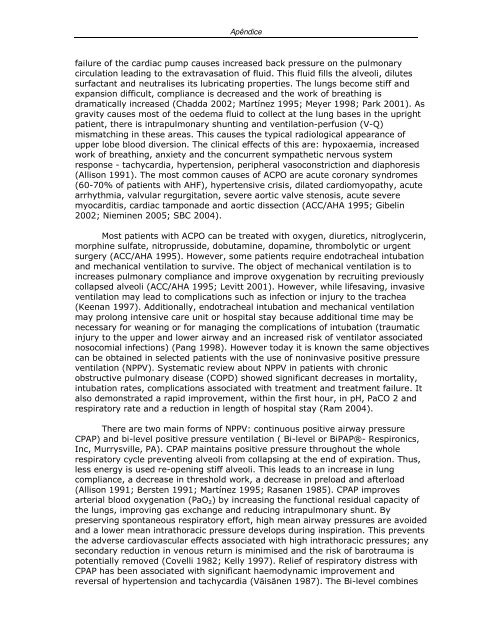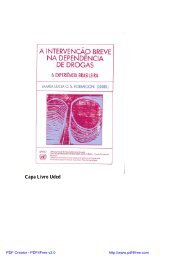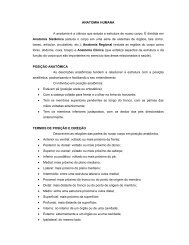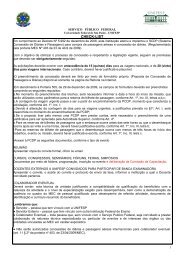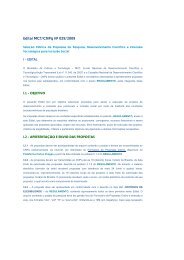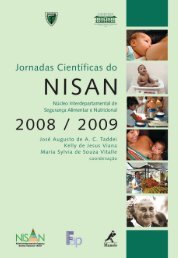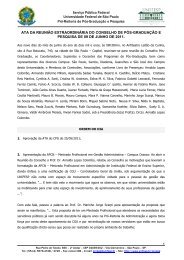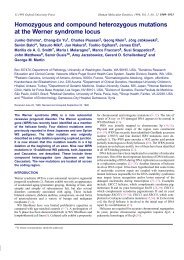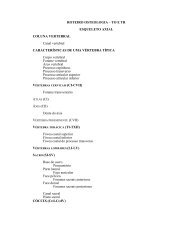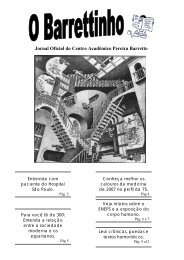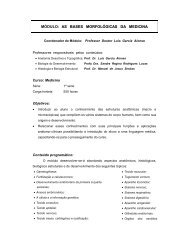flávia maria ribeiro vital efetividade e segurança da - Unifesp
flávia maria ribeiro vital efetividade e segurança da - Unifesp
flávia maria ribeiro vital efetividade e segurança da - Unifesp
You also want an ePaper? Increase the reach of your titles
YUMPU automatically turns print PDFs into web optimized ePapers that Google loves.
Apêndice<br />
failure of the cardiac pump causes increased back pressure on the pulmonary<br />
circulation leading to the extravasation of fluid. This fluid fills the alveoli, dilutes<br />
surfactant and neutralises its lubricating properties. The lungs become stiff and<br />
expansion difficult, compliance is decreased and the work of breathing is<br />
dramatically increased (Chad<strong>da</strong> 2002; Martínez 1995; Meyer 1998; Park 2001). As<br />
gravity causes most of the oedema fluid to collect at the lung bases in the upright<br />
patient, there is intrapulmonary shunting and ventilation-perfusion (V-Q)<br />
mismatching in these areas. This causes the typical radiological appearance of<br />
upper lobe blood diversion. The clinical effects of this are: hypoxaemia, increased<br />
work of breathing, anxiety and the concurrent sympathetic nervous system<br />
response - tachycardia, hypertension, peripheral vasoconstriction and diaphoresis<br />
(Allison 1991). The most common causes of ACPO are acute coronary syndromes<br />
(60-70% of patients with AHF), hypertensive crisis, dilated cardiomyopathy, acute<br />
arrhythmia, valvular regurgitation, severe aortic valve stenosis, acute severe<br />
myocarditis, cardiac tamponade and aortic dissection (ACC/AHA 1995; Gibelin<br />
2002; Nieminen 2005; SBC 2004).<br />
Most patients with ACPO can be treated with oxygen, diuretics, nitroglycerin,<br />
morphine sulfate, nitroprusside, dobutamine, dopamine, thrombolytic or urgent<br />
surgery (ACC/AHA 1995). However, some patients require endotracheal intubation<br />
and mechanical ventilation to survive. The object of mechanical ventilation is to<br />
increases pulmonary compliance and improve oxygenation by recruiting previously<br />
collapsed alveoli (ACC/AHA 1995; Levitt 2001). However, while lifesaving, invasive<br />
ventilation may lead to complications such as infection or injury to the trachea<br />
(Keenan 1997). Additionally, endotracheal intubation and mechanical ventilation<br />
may prolong intensive care unit or hospital stay because additional time may be<br />
necessary for weaning or for managing the complications of intubation (traumatic<br />
injury to the upper and lower airway and an increased risk of ventilator associated<br />
nosocomial infections) (Pang 1998). However to<strong>da</strong>y it is known the same objectives<br />
can be obtained in selected patients with the use of noninvasive positive pressure<br />
ventilation (NPPV). Systematic review about NPPV in patients with chronic<br />
obstructive pulmonary disease (COPD) showed significant decreases in mortality,<br />
intubation rates, complications associated with treatment and treatment failure. It<br />
also demonstrated a rapid improvement, within the first hour, in pH, PaCO 2 and<br />
respiratory rate and a reduction in length of hospital stay (Ram 2004).<br />
There are two main forms of NPPV: continuous positive airway pressure<br />
CPAP) and bi-level positive pressure ventilation ( Bi-level or BiPAP®- Respironics,<br />
Inc, Murrysville, PA). CPAP maintains positive pressure throughout the whole<br />
respiratory cycle preventing alveoli from collapsing at the end of expiration. Thus,<br />
less energy is used re-opening stiff alveoli. This leads to an increase in lung<br />
compliance, a decrease in threshold work, a decrease in preload and afterload<br />
(Allison 1991; Bersten 1991; Martínez 1995; Rasanen 1985). CPAP improves<br />
arterial blood oxygenation (PaO 2 ) by increasing the functional residual capacity of<br />
the lungs, improving gas exchange and reducing intrapulmonary shunt. By<br />
preserving spontaneous respiratory effort, high mean airway pressures are avoided<br />
and a lower mean intrathoracic pressure develops during inspiration. This prevents<br />
the adverse cardiovascular effects associated with high intrathoracic pressures; any<br />
secon<strong>da</strong>ry reduction in venous return is minimised and the risk of barotrauma is<br />
potentially removed (Covelli 1982; Kelly 1997). Relief of respiratory distress with<br />
CPAP has been associated with significant haemodynamic improvement and<br />
reversal of hypertension and tachycardia (Väisänen 1987). The Bi-level combines


